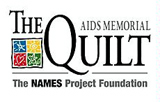First Glimpse of The AIDS Memorial Quilt In Washington This Week

Bringing all 48,000 panels of The Quilt to Washington this summer is no small task, as noted in USA TodayExit Disclaimer just last Friday, but The NAMES Project Foundation – 17,000 staff and volunteer hours later – is doing just that. We will see the first part of The Quilt starting this week, with the Smithsonian Folklife Festival kicking off on Wednesday, June 27.
In order to make all 48,000 panels available for the public to see in Washington, D.C., this summer, it will take more than 60 distinct displays in numerous locations over the course of 31 days:
- 8,000 Quilt panels -- 800 per day -- will be on display over the 10 days of the Smithsonian Folklife Festival as part of "Creativity and Crisis: Unfolding The AIDS Memorial Quilt" from June 27 to July 8.
- 4,800 Quilt panels will be featured in more than 50 venues throughout the capital region from July 21 to 25 during the international AIDS 2012 conference also taking place in Washington.
- 35,200 panels -- 8,800 per day -- will be on display, also July 21-25, on a portion of the National Mall, from 8th to 14th Streets.

First up: “Creativity and CrisisExit Disclaimer" at the Smithsonian Folklife Festival. The Smithsonian Center for Folklife and Cultural Heritage and the NAMES Project have developed the 10-day program to let the public experience how art brings people together to grieve, heal, and educate in the age of HIV/AIDS. Each day, panels from The Quilt will be unfolded for display, then folded back up at the end of the day to make room for the next day’s panels. Inside the Festival’s tents, there will be a wide variety of interactive programs that encourage visitors to engage with the Quilt. For example, in one tent, Quilt makers and artisans will be on hand to guide participants through making their own Quilt panel or contributing to one already in progress. Another tent will take visitors back to Market Street, San Francisco, 1987, where the Quilt began. Theatrical performances, dances, and oral story telling presentations throughout the Festival show how other art forms have been inspired by The Quilt and AIDS epidemic. A schedule of events is available onlineExit Disclaimer.
Also at the Festival, for the first time the Digital Quilt will be available to the public on large touch screens. In addition to browsing images of each panel with the touch of a finger, visitors can contribute stories and comments, enriching The Quilt in real time, and a mobile web app will allow visitors to locate specific panels in D.C. The digitization of The Quilt will transform the longest running folk art piece into a social, crowd sourced project.
There are still many opportunities to get involved with The Quilt this summer whether you live in Washington or elsewhere. Updated information about The Quilt’s return to the nation’s capital and related events can be found at Quilt2012.orgExit Disclaimer.